Auditing and Assurance Services Name of the University Author's Note
VerifiedAdded on 2023/04/23
|18
|3975
|474
AI Summary
Contribute Materials
Your contribution can guide someone’s learning journey. Share your
documents today.
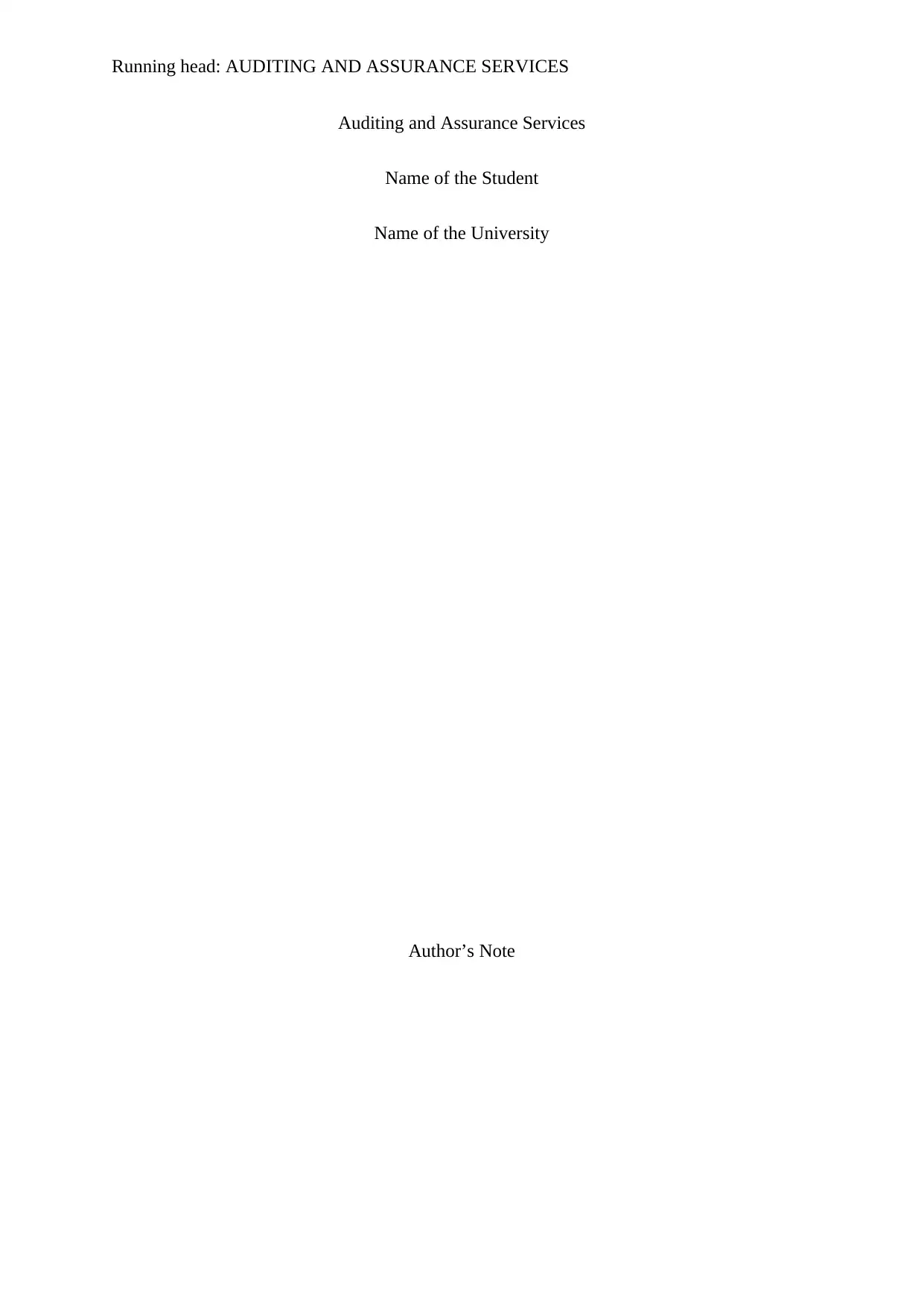
Running head: AUDITING AND ASSURANCE SERVICES
Auditing and Assurance Services
Name of the Student
Name of the University
Author’s Note
Auditing and Assurance Services
Name of the Student
Name of the University
Author’s Note
Secure Best Marks with AI Grader
Need help grading? Try our AI Grader for instant feedback on your assignments.

1AUDITING AND ASSURANCE SERVICES
Table of Contents
Question 1: Advanced Computer Solutions...............................................................................2
Requirement a: Assertions.....................................................................................................2
Requirement b: Substantive Audit Procedures......................................................................3
Requirement c: ASA 701.......................................................................................................4
ASA 701 Communicating Key Audit Matters....................................................................4
Determination Rationales...................................................................................................4
Required Disclosure...........................................................................................................5
Question 2: Green Machine Ltd.................................................................................................6
Requirement a: Assertions.....................................................................................................6
Requirement b: Substantive Audit Procedures......................................................................7
Requirement c: ASA 701.......................................................................................................8
ASA 701 Communicating Key Audit Matters....................................................................8
Determination Rationales...................................................................................................9
Required Disclosure...........................................................................................................9
References................................................................................................................................12
Appendices...............................................................................................................................15
Question 1: Advanced Computer Solutions
Requirement a: Assertions
Table of Contents
Question 1: Advanced Computer Solutions...............................................................................2
Requirement a: Assertions.....................................................................................................2
Requirement b: Substantive Audit Procedures......................................................................3
Requirement c: ASA 701.......................................................................................................4
ASA 701 Communicating Key Audit Matters....................................................................4
Determination Rationales...................................................................................................4
Required Disclosure...........................................................................................................5
Question 2: Green Machine Ltd.................................................................................................6
Requirement a: Assertions.....................................................................................................6
Requirement b: Substantive Audit Procedures......................................................................7
Requirement c: ASA 701.......................................................................................................8
ASA 701 Communicating Key Audit Matters....................................................................8
Determination Rationales...................................................................................................9
Required Disclosure...........................................................................................................9
References................................................................................................................................12
Appendices...............................................................................................................................15
Question 1: Advanced Computer Solutions
Requirement a: Assertions
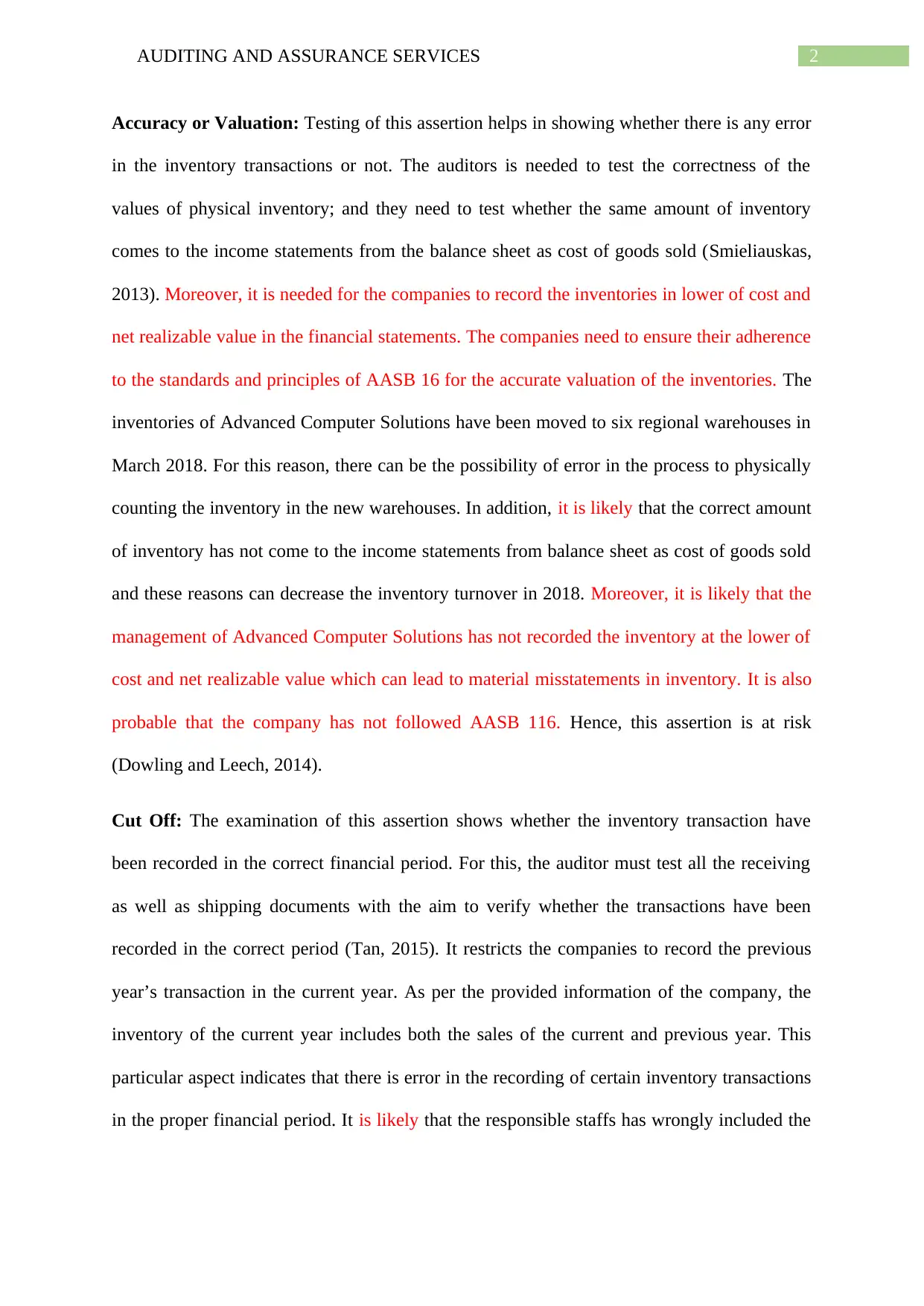
2AUDITING AND ASSURANCE SERVICES
Accuracy or Valuation: Testing of this assertion helps in showing whether there is any error
in the inventory transactions or not. The auditors is needed to test the correctness of the
values of physical inventory; and they need to test whether the same amount of inventory
comes to the income statements from the balance sheet as cost of goods sold (Smieliauskas,
2013). Moreover, it is needed for the companies to record the inventories in lower of cost and
net realizable value in the financial statements. The companies need to ensure their adherence
to the standards and principles of AASB 16 for the accurate valuation of the inventories. The
inventories of Advanced Computer Solutions have been moved to six regional warehouses in
March 2018. For this reason, there can be the possibility of error in the process to physically
counting the inventory in the new warehouses. In addition, it is likely that the correct amount
of inventory has not come to the income statements from balance sheet as cost of goods sold
and these reasons can decrease the inventory turnover in 2018. Moreover, it is likely that the
management of Advanced Computer Solutions has not recorded the inventory at the lower of
cost and net realizable value which can lead to material misstatements in inventory. It is also
probable that the company has not followed AASB 116. Hence, this assertion is at risk
(Dowling and Leech, 2014).
Cut Off: The examination of this assertion shows whether the inventory transaction have
been recorded in the correct financial period. For this, the auditor must test all the receiving
as well as shipping documents with the aim to verify whether the transactions have been
recorded in the correct period (Tan, 2015). It restricts the companies to record the previous
year’s transaction in the current year. As per the provided information of the company, the
inventory of the current year includes both the sales of the current and previous year. This
particular aspect indicates that there is error in the recording of certain inventory transactions
in the proper financial period. It is likely that the responsible staffs has wrongly included the
Accuracy or Valuation: Testing of this assertion helps in showing whether there is any error
in the inventory transactions or not. The auditors is needed to test the correctness of the
values of physical inventory; and they need to test whether the same amount of inventory
comes to the income statements from the balance sheet as cost of goods sold (Smieliauskas,
2013). Moreover, it is needed for the companies to record the inventories in lower of cost and
net realizable value in the financial statements. The companies need to ensure their adherence
to the standards and principles of AASB 16 for the accurate valuation of the inventories. The
inventories of Advanced Computer Solutions have been moved to six regional warehouses in
March 2018. For this reason, there can be the possibility of error in the process to physically
counting the inventory in the new warehouses. In addition, it is likely that the correct amount
of inventory has not come to the income statements from balance sheet as cost of goods sold
and these reasons can decrease the inventory turnover in 2018. Moreover, it is likely that the
management of Advanced Computer Solutions has not recorded the inventory at the lower of
cost and net realizable value which can lead to material misstatements in inventory. It is also
probable that the company has not followed AASB 116. Hence, this assertion is at risk
(Dowling and Leech, 2014).
Cut Off: The examination of this assertion shows whether the inventory transaction have
been recorded in the correct financial period. For this, the auditor must test all the receiving
as well as shipping documents with the aim to verify whether the transactions have been
recorded in the correct period (Tan, 2015). It restricts the companies to record the previous
year’s transaction in the current year. As per the provided information of the company, the
inventory of the current year includes both the sales of the current and previous year. This
particular aspect indicates that there is error in the recording of certain inventory transactions
in the proper financial period. It is likely that the responsible staffs has wrongly included the
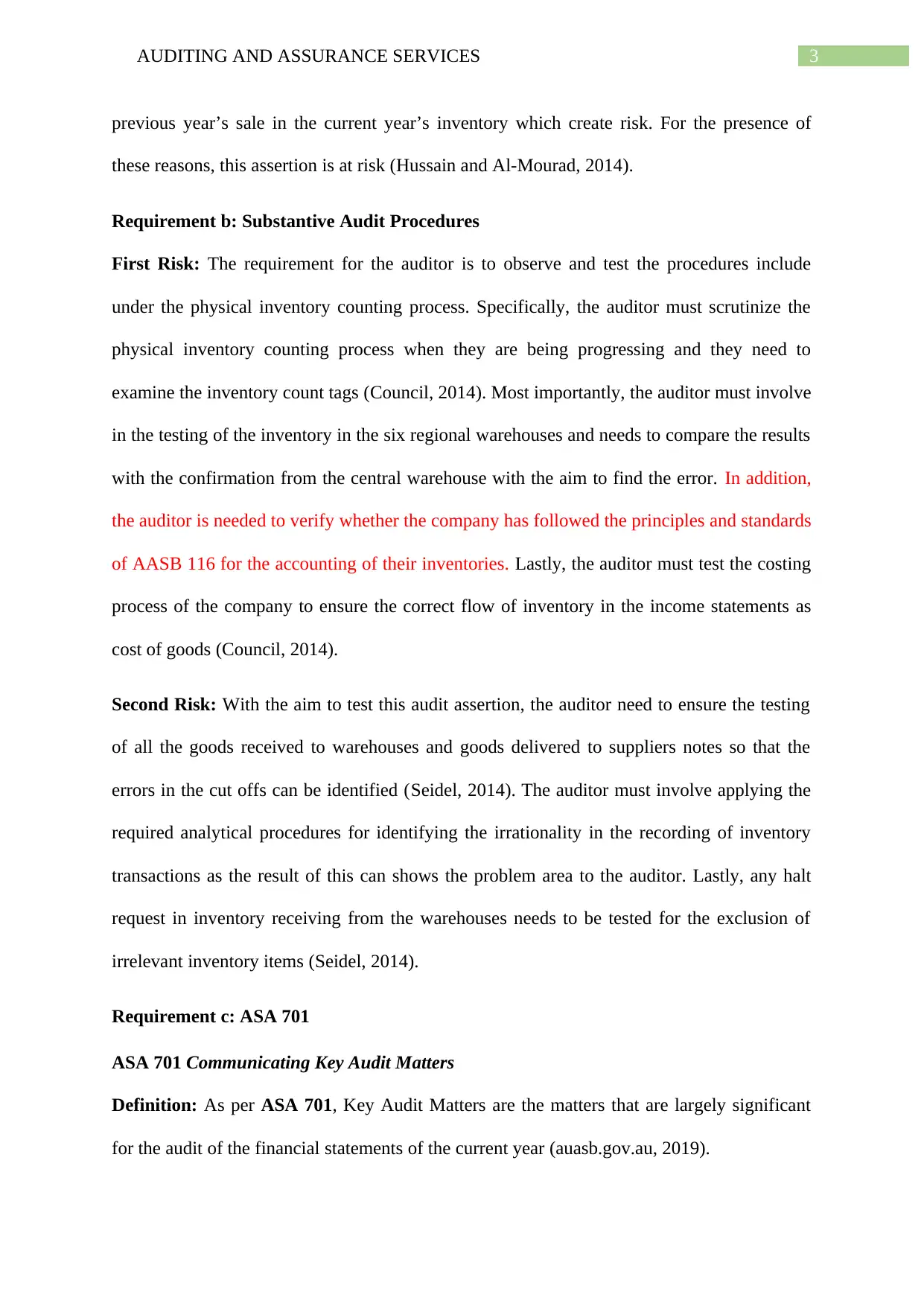
3AUDITING AND ASSURANCE SERVICES
previous year’s sale in the current year’s inventory which create risk. For the presence of
these reasons, this assertion is at risk (Hussain and Al-Mourad, 2014).
Requirement b: Substantive Audit Procedures
First Risk: The requirement for the auditor is to observe and test the procedures include
under the physical inventory counting process. Specifically, the auditor must scrutinize the
physical inventory counting process when they are being progressing and they need to
examine the inventory count tags (Council, 2014). Most importantly, the auditor must involve
in the testing of the inventory in the six regional warehouses and needs to compare the results
with the confirmation from the central warehouse with the aim to find the error. In addition,
the auditor is needed to verify whether the company has followed the principles and standards
of AASB 116 for the accounting of their inventories. Lastly, the auditor must test the costing
process of the company to ensure the correct flow of inventory in the income statements as
cost of goods (Council, 2014).
Second Risk: With the aim to test this audit assertion, the auditor need to ensure the testing
of all the goods received to warehouses and goods delivered to suppliers notes so that the
errors in the cut offs can be identified (Seidel, 2014). The auditor must involve applying the
required analytical procedures for identifying the irrationality in the recording of inventory
transactions as the result of this can shows the problem area to the auditor. Lastly, any halt
request in inventory receiving from the warehouses needs to be tested for the exclusion of
irrelevant inventory items (Seidel, 2014).
Requirement c: ASA 701
ASA 701 Communicating Key Audit Matters
Definition: As per ASA 701, Key Audit Matters are the matters that are largely significant
for the audit of the financial statements of the current year (auasb.gov.au, 2019).
previous year’s sale in the current year’s inventory which create risk. For the presence of
these reasons, this assertion is at risk (Hussain and Al-Mourad, 2014).
Requirement b: Substantive Audit Procedures
First Risk: The requirement for the auditor is to observe and test the procedures include
under the physical inventory counting process. Specifically, the auditor must scrutinize the
physical inventory counting process when they are being progressing and they need to
examine the inventory count tags (Council, 2014). Most importantly, the auditor must involve
in the testing of the inventory in the six regional warehouses and needs to compare the results
with the confirmation from the central warehouse with the aim to find the error. In addition,
the auditor is needed to verify whether the company has followed the principles and standards
of AASB 116 for the accounting of their inventories. Lastly, the auditor must test the costing
process of the company to ensure the correct flow of inventory in the income statements as
cost of goods (Council, 2014).
Second Risk: With the aim to test this audit assertion, the auditor need to ensure the testing
of all the goods received to warehouses and goods delivered to suppliers notes so that the
errors in the cut offs can be identified (Seidel, 2014). The auditor must involve applying the
required analytical procedures for identifying the irrationality in the recording of inventory
transactions as the result of this can shows the problem area to the auditor. Lastly, any halt
request in inventory receiving from the warehouses needs to be tested for the exclusion of
irrelevant inventory items (Seidel, 2014).
Requirement c: ASA 701
ASA 701 Communicating Key Audit Matters
Definition: As per ASA 701, Key Audit Matters are the matters that are largely significant
for the audit of the financial statements of the current year (auasb.gov.au, 2019).
Secure Best Marks with AI Grader
Need help grading? Try our AI Grader for instant feedback on your assignments.
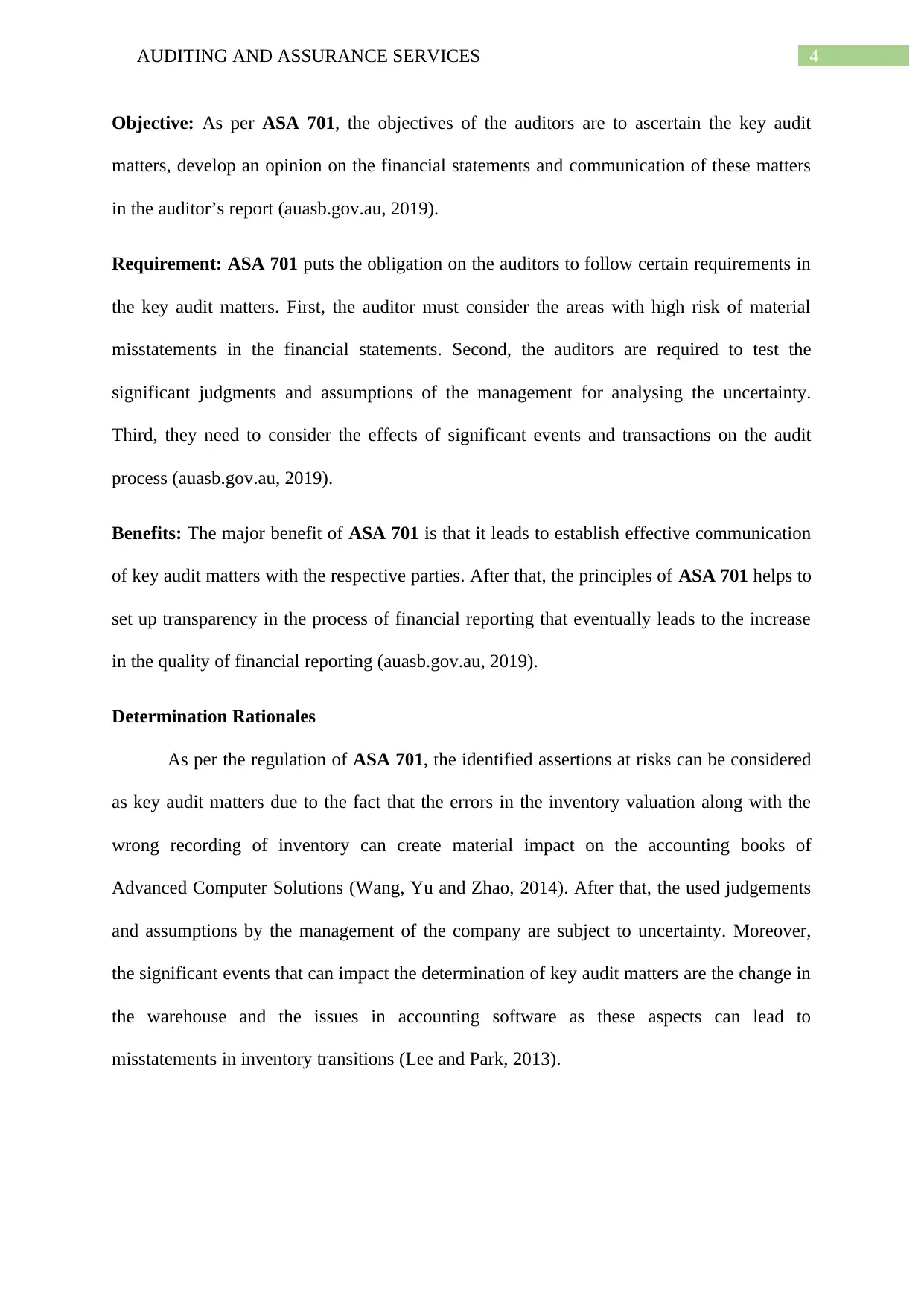
4AUDITING AND ASSURANCE SERVICES
Objective: As per ASA 701, the objectives of the auditors are to ascertain the key audit
matters, develop an opinion on the financial statements and communication of these matters
in the auditor’s report (auasb.gov.au, 2019).
Requirement: ASA 701 puts the obligation on the auditors to follow certain requirements in
the key audit matters. First, the auditor must consider the areas with high risk of material
misstatements in the financial statements. Second, the auditors are required to test the
significant judgments and assumptions of the management for analysing the uncertainty.
Third, they need to consider the effects of significant events and transactions on the audit
process (auasb.gov.au, 2019).
Benefits: The major benefit of ASA 701 is that it leads to establish effective communication
of key audit matters with the respective parties. After that, the principles of ASA 701 helps to
set up transparency in the process of financial reporting that eventually leads to the increase
in the quality of financial reporting (auasb.gov.au, 2019).
Determination Rationales
As per the regulation of ASA 701, the identified assertions at risks can be considered
as key audit matters due to the fact that the errors in the inventory valuation along with the
wrong recording of inventory can create material impact on the accounting books of
Advanced Computer Solutions (Wang, Yu and Zhao, 2014). After that, the used judgements
and assumptions by the management of the company are subject to uncertainty. Moreover,
the significant events that can impact the determination of key audit matters are the change in
the warehouse and the issues in accounting software as these aspects can lead to
misstatements in inventory transitions (Lee and Park, 2013).
Objective: As per ASA 701, the objectives of the auditors are to ascertain the key audit
matters, develop an opinion on the financial statements and communication of these matters
in the auditor’s report (auasb.gov.au, 2019).
Requirement: ASA 701 puts the obligation on the auditors to follow certain requirements in
the key audit matters. First, the auditor must consider the areas with high risk of material
misstatements in the financial statements. Second, the auditors are required to test the
significant judgments and assumptions of the management for analysing the uncertainty.
Third, they need to consider the effects of significant events and transactions on the audit
process (auasb.gov.au, 2019).
Benefits: The major benefit of ASA 701 is that it leads to establish effective communication
of key audit matters with the respective parties. After that, the principles of ASA 701 helps to
set up transparency in the process of financial reporting that eventually leads to the increase
in the quality of financial reporting (auasb.gov.au, 2019).
Determination Rationales
As per the regulation of ASA 701, the identified assertions at risks can be considered
as key audit matters due to the fact that the errors in the inventory valuation along with the
wrong recording of inventory can create material impact on the accounting books of
Advanced Computer Solutions (Wang, Yu and Zhao, 2014). After that, the used judgements
and assumptions by the management of the company are subject to uncertainty. Moreover,
the significant events that can impact the determination of key audit matters are the change in
the warehouse and the issues in accounting software as these aspects can lead to
misstatements in inventory transitions (Lee and Park, 2013).
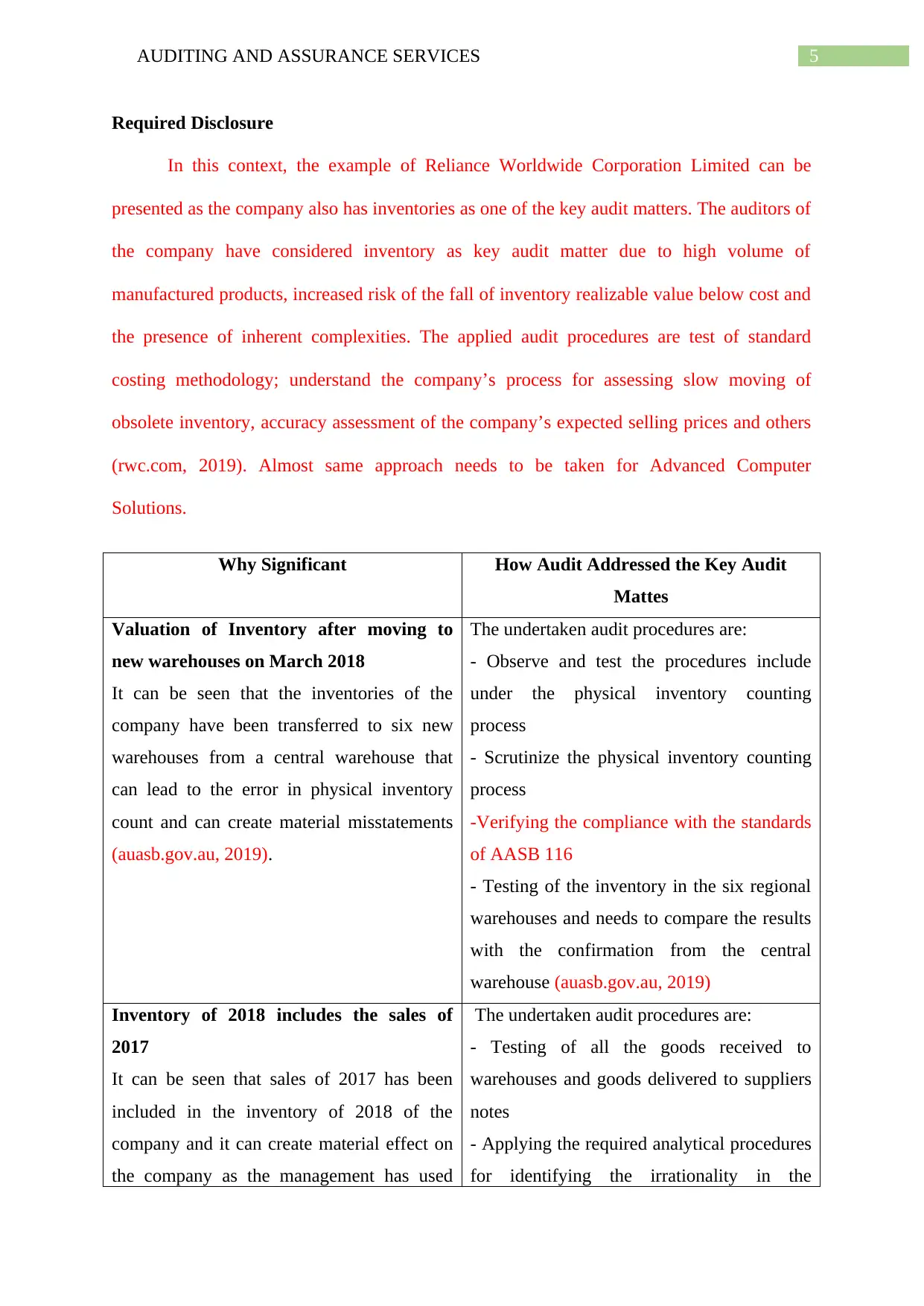
5AUDITING AND ASSURANCE SERVICES
Required Disclosure
In this context, the example of Reliance Worldwide Corporation Limited can be
presented as the company also has inventories as one of the key audit matters. The auditors of
the company have considered inventory as key audit matter due to high volume of
manufactured products, increased risk of the fall of inventory realizable value below cost and
the presence of inherent complexities. The applied audit procedures are test of standard
costing methodology; understand the company’s process for assessing slow moving of
obsolete inventory, accuracy assessment of the company’s expected selling prices and others
(rwc.com, 2019). Almost same approach needs to be taken for Advanced Computer
Solutions.
Why Significant How Audit Addressed the Key Audit
Mattes
Valuation of Inventory after moving to
new warehouses on March 2018
It can be seen that the inventories of the
company have been transferred to six new
warehouses from a central warehouse that
can lead to the error in physical inventory
count and can create material misstatements
(auasb.gov.au, 2019).
The undertaken audit procedures are:
- Observe and test the procedures include
under the physical inventory counting
process
- Scrutinize the physical inventory counting
process
-Verifying the compliance with the standards
of AASB 116
- Testing of the inventory in the six regional
warehouses and needs to compare the results
with the confirmation from the central
warehouse (auasb.gov.au, 2019)
Inventory of 2018 includes the sales of
2017
It can be seen that sales of 2017 has been
included in the inventory of 2018 of the
company and it can create material effect on
the company as the management has used
The undertaken audit procedures are:
- Testing of all the goods received to
warehouses and goods delivered to suppliers
notes
- Applying the required analytical procedures
for identifying the irrationality in the
Required Disclosure
In this context, the example of Reliance Worldwide Corporation Limited can be
presented as the company also has inventories as one of the key audit matters. The auditors of
the company have considered inventory as key audit matter due to high volume of
manufactured products, increased risk of the fall of inventory realizable value below cost and
the presence of inherent complexities. The applied audit procedures are test of standard
costing methodology; understand the company’s process for assessing slow moving of
obsolete inventory, accuracy assessment of the company’s expected selling prices and others
(rwc.com, 2019). Almost same approach needs to be taken for Advanced Computer
Solutions.
Why Significant How Audit Addressed the Key Audit
Mattes
Valuation of Inventory after moving to
new warehouses on March 2018
It can be seen that the inventories of the
company have been transferred to six new
warehouses from a central warehouse that
can lead to the error in physical inventory
count and can create material misstatements
(auasb.gov.au, 2019).
The undertaken audit procedures are:
- Observe and test the procedures include
under the physical inventory counting
process
- Scrutinize the physical inventory counting
process
-Verifying the compliance with the standards
of AASB 116
- Testing of the inventory in the six regional
warehouses and needs to compare the results
with the confirmation from the central
warehouse (auasb.gov.au, 2019)
Inventory of 2018 includes the sales of
2017
It can be seen that sales of 2017 has been
included in the inventory of 2018 of the
company and it can create material effect on
the company as the management has used
The undertaken audit procedures are:
- Testing of all the goods received to
warehouses and goods delivered to suppliers
notes
- Applying the required analytical procedures
for identifying the irrationality in the
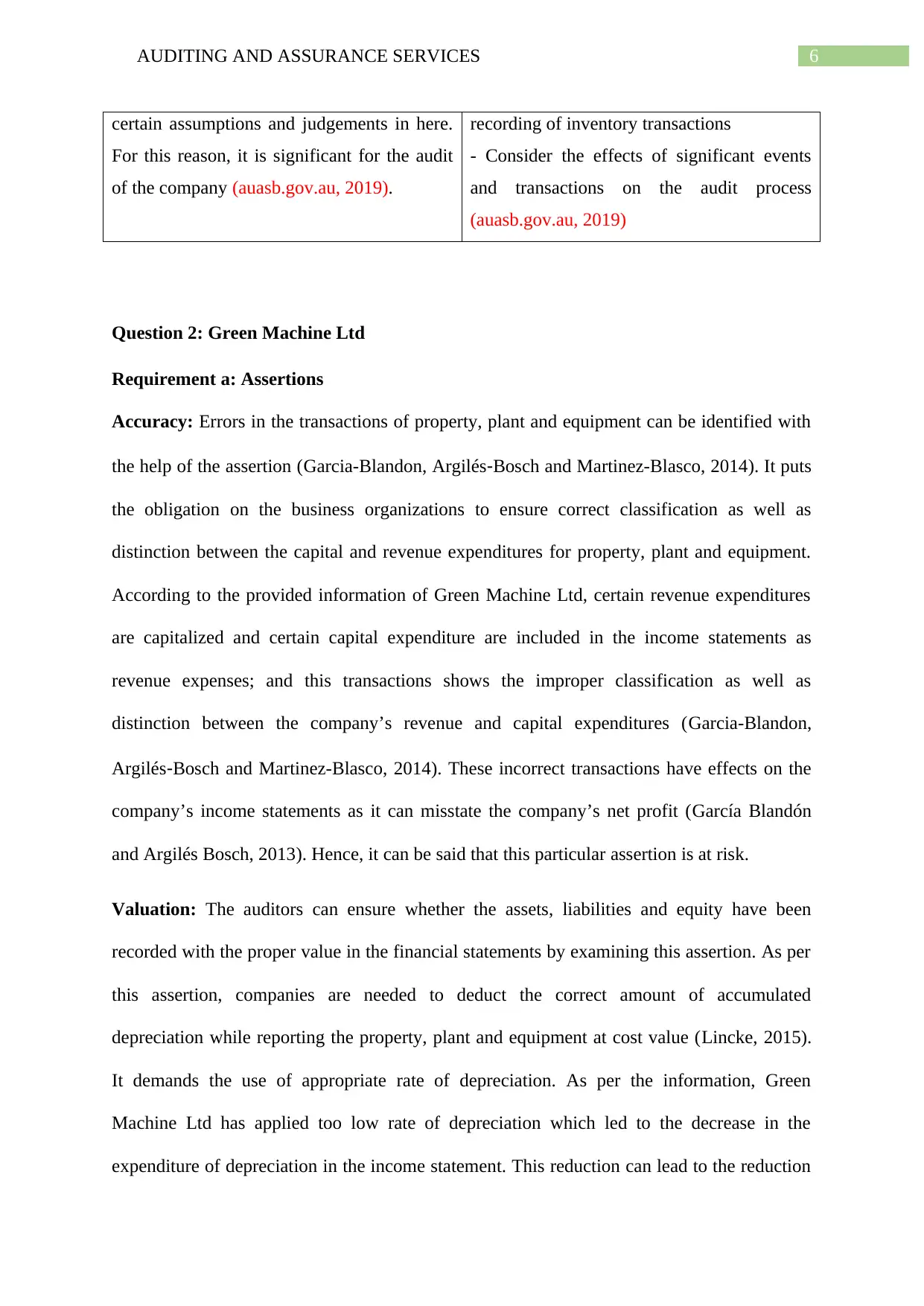
6AUDITING AND ASSURANCE SERVICES
certain assumptions and judgements in here.
For this reason, it is significant for the audit
of the company (auasb.gov.au, 2019).
recording of inventory transactions
- Consider the effects of significant events
and transactions on the audit process
(auasb.gov.au, 2019)
Question 2: Green Machine Ltd
Requirement a: Assertions
Accuracy: Errors in the transactions of property, plant and equipment can be identified with
the help of the assertion (Garcia-Blandon, Argilés‐Bosch and Martinez-Blasco, 2014). It puts
the obligation on the business organizations to ensure correct classification as well as
distinction between the capital and revenue expenditures for property, plant and equipment.
According to the provided information of Green Machine Ltd, certain revenue expenditures
are capitalized and certain capital expenditure are included in the income statements as
revenue expenses; and this transactions shows the improper classification as well as
distinction between the company’s revenue and capital expenditures (Garcia-Blandon,
Argilés‐Bosch and Martinez-Blasco, 2014). These incorrect transactions have effects on the
company’s income statements as it can misstate the company’s net profit (García Blandón
and Argilés Bosch, 2013). Hence, it can be said that this particular assertion is at risk.
Valuation: The auditors can ensure whether the assets, liabilities and equity have been
recorded with the proper value in the financial statements by examining this assertion. As per
this assertion, companies are needed to deduct the correct amount of accumulated
depreciation while reporting the property, plant and equipment at cost value (Lincke, 2015).
It demands the use of appropriate rate of depreciation. As per the information, Green
Machine Ltd has applied too low rate of depreciation which led to the decrease in the
expenditure of depreciation in the income statement. This reduction can lead to the reduction
certain assumptions and judgements in here.
For this reason, it is significant for the audit
of the company (auasb.gov.au, 2019).
recording of inventory transactions
- Consider the effects of significant events
and transactions on the audit process
(auasb.gov.au, 2019)
Question 2: Green Machine Ltd
Requirement a: Assertions
Accuracy: Errors in the transactions of property, plant and equipment can be identified with
the help of the assertion (Garcia-Blandon, Argilés‐Bosch and Martinez-Blasco, 2014). It puts
the obligation on the business organizations to ensure correct classification as well as
distinction between the capital and revenue expenditures for property, plant and equipment.
According to the provided information of Green Machine Ltd, certain revenue expenditures
are capitalized and certain capital expenditure are included in the income statements as
revenue expenses; and this transactions shows the improper classification as well as
distinction between the company’s revenue and capital expenditures (Garcia-Blandon,
Argilés‐Bosch and Martinez-Blasco, 2014). These incorrect transactions have effects on the
company’s income statements as it can misstate the company’s net profit (García Blandón
and Argilés Bosch, 2013). Hence, it can be said that this particular assertion is at risk.
Valuation: The auditors can ensure whether the assets, liabilities and equity have been
recorded with the proper value in the financial statements by examining this assertion. As per
this assertion, companies are needed to deduct the correct amount of accumulated
depreciation while reporting the property, plant and equipment at cost value (Lincke, 2015).
It demands the use of appropriate rate of depreciation. As per the information, Green
Machine Ltd has applied too low rate of depreciation which led to the decrease in the
expenditure of depreciation in the income statement. This reduction can lead to the reduction
Paraphrase This Document
Need a fresh take? Get an instant paraphrase of this document with our AI Paraphraser

7AUDITING AND ASSURANCE SERVICES
in the operating expenses of the company that can sprightly contribute towards the
misstatements of net profit. At the same time, improper application of depreciation rate
indicates towards the fact that the company has not been able to report the correct value of
their property, plant and equipment in the financial statements (Johnson, Keune and Winchel,
2014). Hence, this assertion is at the risk.
Requirement b: Substantive Audit Procedures
First Risk: Due to the wrong division between the capital and revenue expenditures, there
can be material impacts on the company’s financial statements. Hence, the substantive audit
procedure is the review the property, plant and equipment related expenses in the company.
At the same time, reviewing the policies and procedures of the company for the capitalization
of the expenses related to property, plant and equipment is another crucial audit procedure
that the auditor needs to consider (Meleshenko and Usanova, 2014). After that, the auditor
needs to undertake evaluating the financial ratios and industry results. In case of the repair
and maintenance expenses, the need for the auditor is to review Green Machine Ltd’s policies
to ensure the aspect that whether the company has recorded them as expenses or they have
been capitalized. After that, the auditor needs to discuss about the company’s management
about the policies and procedures related to capital expenditures and revenue expenditures.
All these processes will make the auditor enable in assessing the fact that which revenue
expenses have been capitalized and which capital expenses have been recorded in profit and
loss account.
Second Risk: For this particular assertion risk, it is needed for the auditor of Green Machine
Ltd to conduct an investigation on the valuation procedure of property, plant and equipment
in the company. With the aim to ensure reasonableness in depreciation, the auditor needs t
ensure checking the fact that whether the useful lives of property, plant and equipment
reflects the rates of depreciation. The main responsibility of the auditor will be the
in the operating expenses of the company that can sprightly contribute towards the
misstatements of net profit. At the same time, improper application of depreciation rate
indicates towards the fact that the company has not been able to report the correct value of
their property, plant and equipment in the financial statements (Johnson, Keune and Winchel,
2014). Hence, this assertion is at the risk.
Requirement b: Substantive Audit Procedures
First Risk: Due to the wrong division between the capital and revenue expenditures, there
can be material impacts on the company’s financial statements. Hence, the substantive audit
procedure is the review the property, plant and equipment related expenses in the company.
At the same time, reviewing the policies and procedures of the company for the capitalization
of the expenses related to property, plant and equipment is another crucial audit procedure
that the auditor needs to consider (Meleshenko and Usanova, 2014). After that, the auditor
needs to undertake evaluating the financial ratios and industry results. In case of the repair
and maintenance expenses, the need for the auditor is to review Green Machine Ltd’s policies
to ensure the aspect that whether the company has recorded them as expenses or they have
been capitalized. After that, the auditor needs to discuss about the company’s management
about the policies and procedures related to capital expenditures and revenue expenditures.
All these processes will make the auditor enable in assessing the fact that which revenue
expenses have been capitalized and which capital expenses have been recorded in profit and
loss account.
Second Risk: For this particular assertion risk, it is needed for the auditor of Green Machine
Ltd to conduct an investigation on the valuation procedure of property, plant and equipment
in the company. With the aim to ensure reasonableness in depreciation, the auditor needs t
ensure checking the fact that whether the useful lives of property, plant and equipment
reflects the rates of depreciation. The main responsibility of the auditor will be the
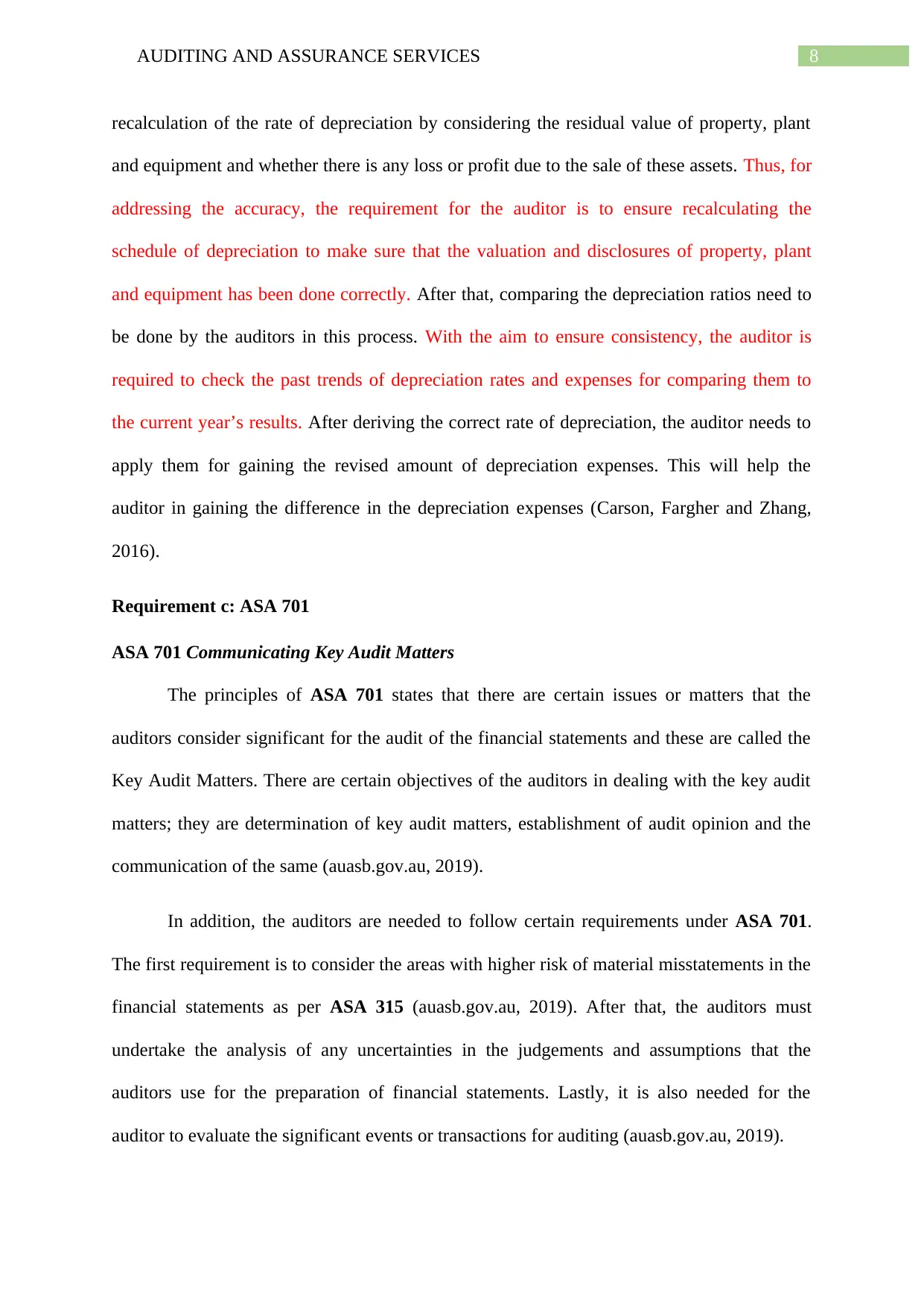
8AUDITING AND ASSURANCE SERVICES
recalculation of the rate of depreciation by considering the residual value of property, plant
and equipment and whether there is any loss or profit due to the sale of these assets. Thus, for
addressing the accuracy, the requirement for the auditor is to ensure recalculating the
schedule of depreciation to make sure that the valuation and disclosures of property, plant
and equipment has been done correctly. After that, comparing the depreciation ratios need to
be done by the auditors in this process. With the aim to ensure consistency, the auditor is
required to check the past trends of depreciation rates and expenses for comparing them to
the current year’s results. After deriving the correct rate of depreciation, the auditor needs to
apply them for gaining the revised amount of depreciation expenses. This will help the
auditor in gaining the difference in the depreciation expenses (Carson, Fargher and Zhang,
2016).
Requirement c: ASA 701
ASA 701 Communicating Key Audit Matters
The principles of ASA 701 states that there are certain issues or matters that the
auditors consider significant for the audit of the financial statements and these are called the
Key Audit Matters. There are certain objectives of the auditors in dealing with the key audit
matters; they are determination of key audit matters, establishment of audit opinion and the
communication of the same (auasb.gov.au, 2019).
In addition, the auditors are needed to follow certain requirements under ASA 701.
The first requirement is to consider the areas with higher risk of material misstatements in the
financial statements as per ASA 315 (auasb.gov.au, 2019). After that, the auditors must
undertake the analysis of any uncertainties in the judgements and assumptions that the
auditors use for the preparation of financial statements. Lastly, it is also needed for the
auditor to evaluate the significant events or transactions for auditing (auasb.gov.au, 2019).
recalculation of the rate of depreciation by considering the residual value of property, plant
and equipment and whether there is any loss or profit due to the sale of these assets. Thus, for
addressing the accuracy, the requirement for the auditor is to ensure recalculating the
schedule of depreciation to make sure that the valuation and disclosures of property, plant
and equipment has been done correctly. After that, comparing the depreciation ratios need to
be done by the auditors in this process. With the aim to ensure consistency, the auditor is
required to check the past trends of depreciation rates and expenses for comparing them to
the current year’s results. After deriving the correct rate of depreciation, the auditor needs to
apply them for gaining the revised amount of depreciation expenses. This will help the
auditor in gaining the difference in the depreciation expenses (Carson, Fargher and Zhang,
2016).
Requirement c: ASA 701
ASA 701 Communicating Key Audit Matters
The principles of ASA 701 states that there are certain issues or matters that the
auditors consider significant for the audit of the financial statements and these are called the
Key Audit Matters. There are certain objectives of the auditors in dealing with the key audit
matters; they are determination of key audit matters, establishment of audit opinion and the
communication of the same (auasb.gov.au, 2019).
In addition, the auditors are needed to follow certain requirements under ASA 701.
The first requirement is to consider the areas with higher risk of material misstatements in the
financial statements as per ASA 315 (auasb.gov.au, 2019). After that, the auditors must
undertake the analysis of any uncertainties in the judgements and assumptions that the
auditors use for the preparation of financial statements. Lastly, it is also needed for the
auditor to evaluate the significant events or transactions for auditing (auasb.gov.au, 2019).
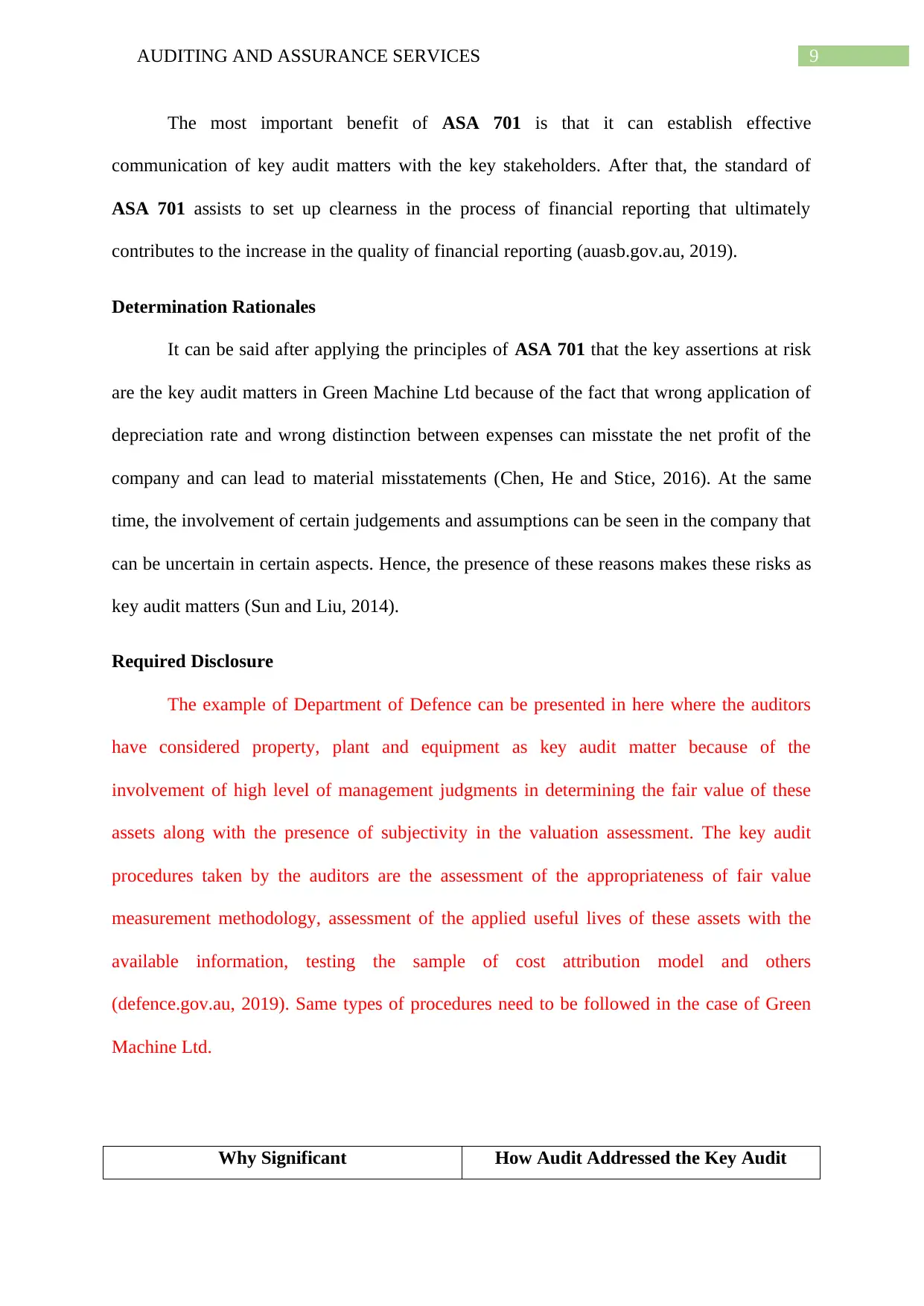
9AUDITING AND ASSURANCE SERVICES
The most important benefit of ASA 701 is that it can establish effective
communication of key audit matters with the key stakeholders. After that, the standard of
ASA 701 assists to set up clearness in the process of financial reporting that ultimately
contributes to the increase in the quality of financial reporting (auasb.gov.au, 2019).
Determination Rationales
It can be said after applying the principles of ASA 701 that the key assertions at risk
are the key audit matters in Green Machine Ltd because of the fact that wrong application of
depreciation rate and wrong distinction between expenses can misstate the net profit of the
company and can lead to material misstatements (Chen, He and Stice, 2016). At the same
time, the involvement of certain judgements and assumptions can be seen in the company that
can be uncertain in certain aspects. Hence, the presence of these reasons makes these risks as
key audit matters (Sun and Liu, 2014).
Required Disclosure
The example of Department of Defence can be presented in here where the auditors
have considered property, plant and equipment as key audit matter because of the
involvement of high level of management judgments in determining the fair value of these
assets along with the presence of subjectivity in the valuation assessment. The key audit
procedures taken by the auditors are the assessment of the appropriateness of fair value
measurement methodology, assessment of the applied useful lives of these assets with the
available information, testing the sample of cost attribution model and others
(defence.gov.au, 2019). Same types of procedures need to be followed in the case of Green
Machine Ltd.
Why Significant How Audit Addressed the Key Audit
The most important benefit of ASA 701 is that it can establish effective
communication of key audit matters with the key stakeholders. After that, the standard of
ASA 701 assists to set up clearness in the process of financial reporting that ultimately
contributes to the increase in the quality of financial reporting (auasb.gov.au, 2019).
Determination Rationales
It can be said after applying the principles of ASA 701 that the key assertions at risk
are the key audit matters in Green Machine Ltd because of the fact that wrong application of
depreciation rate and wrong distinction between expenses can misstate the net profit of the
company and can lead to material misstatements (Chen, He and Stice, 2016). At the same
time, the involvement of certain judgements and assumptions can be seen in the company that
can be uncertain in certain aspects. Hence, the presence of these reasons makes these risks as
key audit matters (Sun and Liu, 2014).
Required Disclosure
The example of Department of Defence can be presented in here where the auditors
have considered property, plant and equipment as key audit matter because of the
involvement of high level of management judgments in determining the fair value of these
assets along with the presence of subjectivity in the valuation assessment. The key audit
procedures taken by the auditors are the assessment of the appropriateness of fair value
measurement methodology, assessment of the applied useful lives of these assets with the
available information, testing the sample of cost attribution model and others
(defence.gov.au, 2019). Same types of procedures need to be followed in the case of Green
Machine Ltd.
Why Significant How Audit Addressed the Key Audit
Secure Best Marks with AI Grader
Need help grading? Try our AI Grader for instant feedback on your assignments.

10AUDITING AND ASSURANCE SERVICES
Mattes
Inappropriate division between revenue
and capital expenses
Some items were capitalized when they
should have been expensed and other capital
items were included in repairs and
maintenance in the income statement. It is
subject to the judgements and assumptions of
management and important for the audit of
the company (auasb.gov.au, 2019).
The undertaken audit procedures are:
- Review the property, plant and equipment
related expenses in the company
- Reviewing the policies and procedures of
the company for the capitalization of the
expenses related to property, plant and
equipment (auasb.gov.au, 2019)
-Evaluating the financial ratios and industry
results
-Review Green Machine Ltd’s policies to
ensure the aspect that whether the company
has recorded them as expenses or they have
been capitalized
-Discuss about the company’s management
about the policies and procedures related to
capital expenditures and revenue
expenditures (auasb.gov.au, 2019)
Low rate of depreciation has been charged
on property, plant and equipment
There is a range of depreciation rates within
categories and there has been concern that the
rates applied to some assets have been too
low. This can create material misstatements
in the financial statements and it involves
certain judgements as well as assumptions of
the management. Hence, it is significant for
the audit of the company (auasb.gov.au,
2019).
The undertaken audit procedures are:
-Checking the fact that whether the useful
lives of property, plant and equipment
reflects the rates of depreciation
-Recalculation of the rate of depreciation by
considering the residual value of property,
plant and equipment and whether there is any
loss or profit due to the sale of these assets
(auasb.gov.au, 2019)
-Recalculating the schedule of depreciation
- comparing the depreciation ratios
-Check the past trends of depreciation rates
and expenses for comparing them to the
current year’s results
-Application of the new depreciation rate to
Mattes
Inappropriate division between revenue
and capital expenses
Some items were capitalized when they
should have been expensed and other capital
items were included in repairs and
maintenance in the income statement. It is
subject to the judgements and assumptions of
management and important for the audit of
the company (auasb.gov.au, 2019).
The undertaken audit procedures are:
- Review the property, plant and equipment
related expenses in the company
- Reviewing the policies and procedures of
the company for the capitalization of the
expenses related to property, plant and
equipment (auasb.gov.au, 2019)
-Evaluating the financial ratios and industry
results
-Review Green Machine Ltd’s policies to
ensure the aspect that whether the company
has recorded them as expenses or they have
been capitalized
-Discuss about the company’s management
about the policies and procedures related to
capital expenditures and revenue
expenditures (auasb.gov.au, 2019)
Low rate of depreciation has been charged
on property, plant and equipment
There is a range of depreciation rates within
categories and there has been concern that the
rates applied to some assets have been too
low. This can create material misstatements
in the financial statements and it involves
certain judgements as well as assumptions of
the management. Hence, it is significant for
the audit of the company (auasb.gov.au,
2019).
The undertaken audit procedures are:
-Checking the fact that whether the useful
lives of property, plant and equipment
reflects the rates of depreciation
-Recalculation of the rate of depreciation by
considering the residual value of property,
plant and equipment and whether there is any
loss or profit due to the sale of these assets
(auasb.gov.au, 2019)
-Recalculating the schedule of depreciation
- comparing the depreciation ratios
-Check the past trends of depreciation rates
and expenses for comparing them to the
current year’s results
-Application of the new depreciation rate to
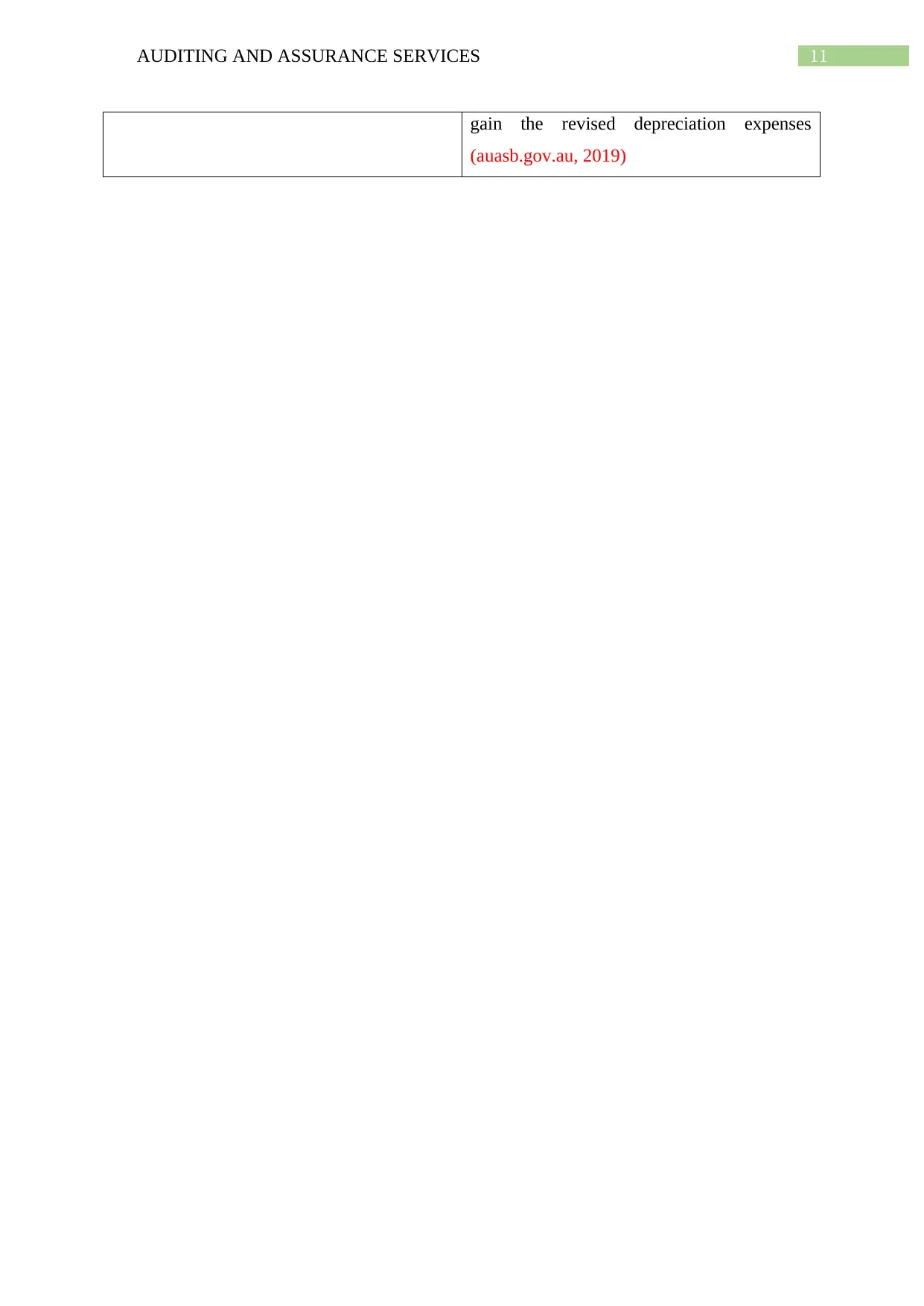
11AUDITING AND ASSURANCE SERVICES
gain the revised depreciation expenses
(auasb.gov.au, 2019)
gain the revised depreciation expenses
(auasb.gov.au, 2019)
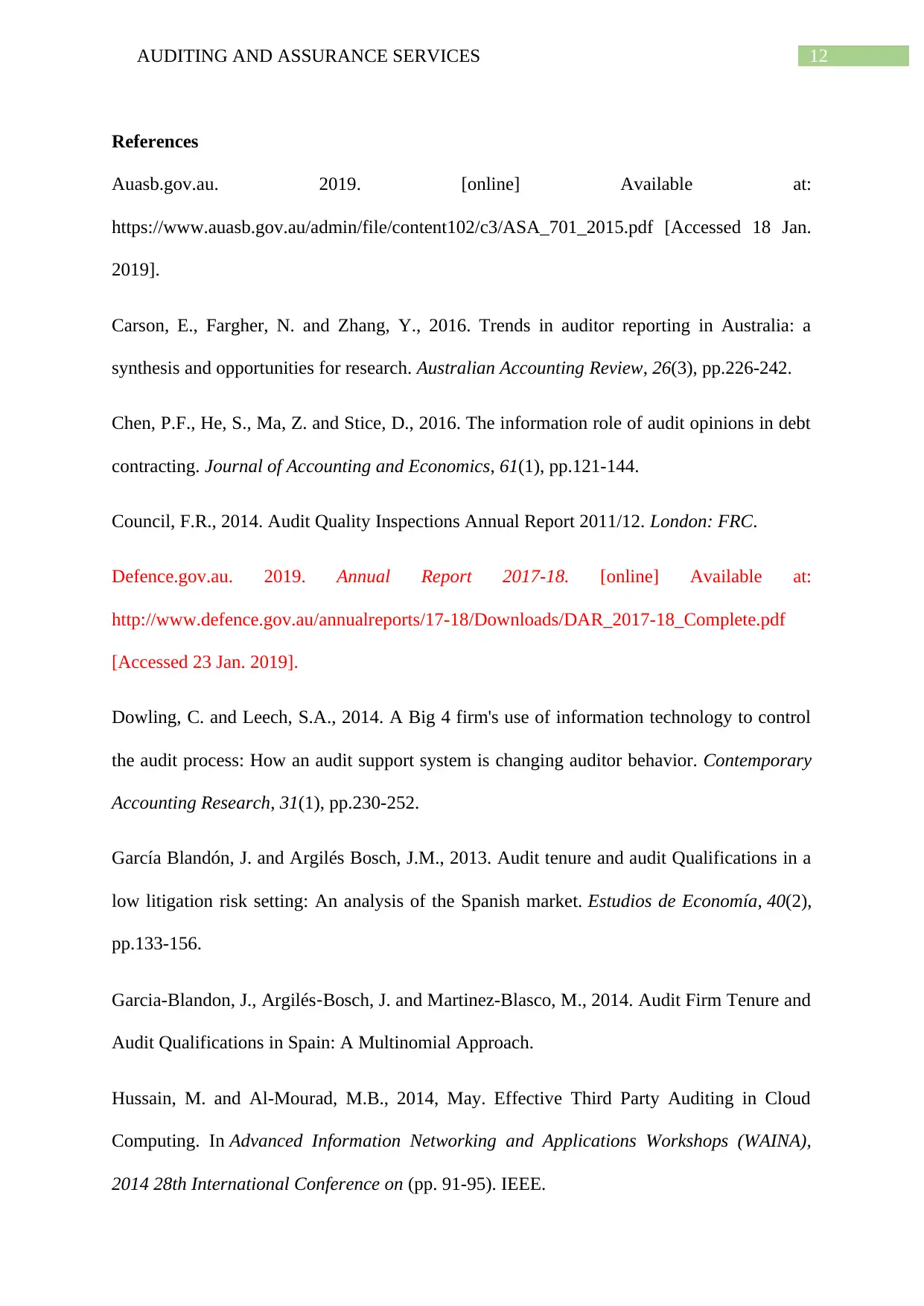
12AUDITING AND ASSURANCE SERVICES
References
Auasb.gov.au. 2019. [online] Available at:
https://www.auasb.gov.au/admin/file/content102/c3/ASA_701_2015.pdf [Accessed 18 Jan.
2019].
Carson, E., Fargher, N. and Zhang, Y., 2016. Trends in auditor reporting in Australia: a
synthesis and opportunities for research. Australian Accounting Review, 26(3), pp.226-242.
Chen, P.F., He, S., Ma, Z. and Stice, D., 2016. The information role of audit opinions in debt
contracting. Journal of Accounting and Economics, 61(1), pp.121-144.
Council, F.R., 2014. Audit Quality Inspections Annual Report 2011/12. London: FRC.
Defence.gov.au. 2019. Annual Report 2017-18. [online] Available at:
http://www.defence.gov.au/annualreports/17-18/Downloads/DAR_2017-18_Complete.pdf
[Accessed 23 Jan. 2019].
Dowling, C. and Leech, S.A., 2014. A Big 4 firm's use of information technology to control
the audit process: How an audit support system is changing auditor behavior. Contemporary
Accounting Research, 31(1), pp.230-252.
García Blandón, J. and Argilés Bosch, J.M., 2013. Audit tenure and audit Qualifications in a
low litigation risk setting: An analysis of the Spanish market. Estudios de Economía, 40(2),
pp.133-156.
Garcia-Blandon, J., Argilés‐Bosch, J. and Martinez-Blasco, M., 2014. Audit Firm Tenure and
Audit Qualifications in Spain: A Multinomial Approach.
Hussain, M. and Al-Mourad, M.B., 2014, May. Effective Third Party Auditing in Cloud
Computing. In Advanced Information Networking and Applications Workshops (WAINA),
2014 28th International Conference on (pp. 91-95). IEEE.
References
Auasb.gov.au. 2019. [online] Available at:
https://www.auasb.gov.au/admin/file/content102/c3/ASA_701_2015.pdf [Accessed 18 Jan.
2019].
Carson, E., Fargher, N. and Zhang, Y., 2016. Trends in auditor reporting in Australia: a
synthesis and opportunities for research. Australian Accounting Review, 26(3), pp.226-242.
Chen, P.F., He, S., Ma, Z. and Stice, D., 2016. The information role of audit opinions in debt
contracting. Journal of Accounting and Economics, 61(1), pp.121-144.
Council, F.R., 2014. Audit Quality Inspections Annual Report 2011/12. London: FRC.
Defence.gov.au. 2019. Annual Report 2017-18. [online] Available at:
http://www.defence.gov.au/annualreports/17-18/Downloads/DAR_2017-18_Complete.pdf
[Accessed 23 Jan. 2019].
Dowling, C. and Leech, S.A., 2014. A Big 4 firm's use of information technology to control
the audit process: How an audit support system is changing auditor behavior. Contemporary
Accounting Research, 31(1), pp.230-252.
García Blandón, J. and Argilés Bosch, J.M., 2013. Audit tenure and audit Qualifications in a
low litigation risk setting: An analysis of the Spanish market. Estudios de Economía, 40(2),
pp.133-156.
Garcia-Blandon, J., Argilés‐Bosch, J. and Martinez-Blasco, M., 2014. Audit Firm Tenure and
Audit Qualifications in Spain: A Multinomial Approach.
Hussain, M. and Al-Mourad, M.B., 2014, May. Effective Third Party Auditing in Cloud
Computing. In Advanced Information Networking and Applications Workshops (WAINA),
2014 28th International Conference on (pp. 91-95). IEEE.
Paraphrase This Document
Need a fresh take? Get an instant paraphrase of this document with our AI Paraphraser
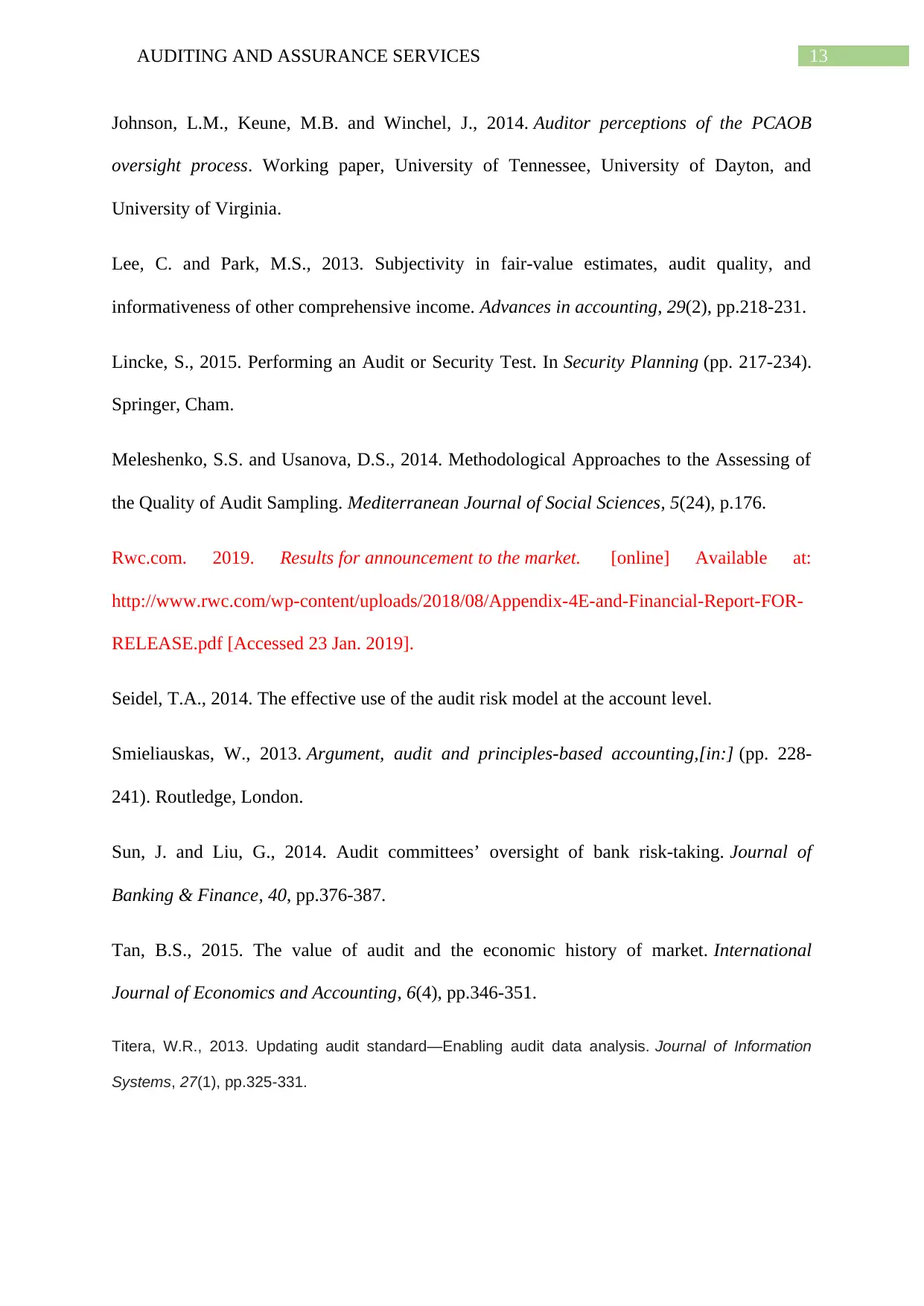
13AUDITING AND ASSURANCE SERVICES
Johnson, L.M., Keune, M.B. and Winchel, J., 2014. Auditor perceptions of the PCAOB
oversight process. Working paper, University of Tennessee, University of Dayton, and
University of Virginia.
Lee, C. and Park, M.S., 2013. Subjectivity in fair-value estimates, audit quality, and
informativeness of other comprehensive income. Advances in accounting, 29(2), pp.218-231.
Lincke, S., 2015. Performing an Audit or Security Test. In Security Planning (pp. 217-234).
Springer, Cham.
Meleshenko, S.S. and Usanova, D.S., 2014. Methodological Approaches to the Assessing of
the Quality of Audit Sampling. Mediterranean Journal of Social Sciences, 5(24), p.176.
Rwc.com. 2019. Results for announcement to the market. [online] Available at:
http://www.rwc.com/wp-content/uploads/2018/08/Appendix-4E-and-Financial-Report-FOR-
RELEASE.pdf [Accessed 23 Jan. 2019].
Seidel, T.A., 2014. The effective use of the audit risk model at the account level.
Smieliauskas, W., 2013. Argument, audit and principles-based accounting,[in:] (pp. 228-
241). Routledge, London.
Sun, J. and Liu, G., 2014. Audit committees’ oversight of bank risk-taking. Journal of
Banking & Finance, 40, pp.376-387.
Tan, B.S., 2015. The value of audit and the economic history of market. International
Journal of Economics and Accounting, 6(4), pp.346-351.
Titera, W.R., 2013. Updating audit standard—Enabling audit data analysis. Journal of Information
Systems, 27(1), pp.325-331.
Johnson, L.M., Keune, M.B. and Winchel, J., 2014. Auditor perceptions of the PCAOB
oversight process. Working paper, University of Tennessee, University of Dayton, and
University of Virginia.
Lee, C. and Park, M.S., 2013. Subjectivity in fair-value estimates, audit quality, and
informativeness of other comprehensive income. Advances in accounting, 29(2), pp.218-231.
Lincke, S., 2015. Performing an Audit or Security Test. In Security Planning (pp. 217-234).
Springer, Cham.
Meleshenko, S.S. and Usanova, D.S., 2014. Methodological Approaches to the Assessing of
the Quality of Audit Sampling. Mediterranean Journal of Social Sciences, 5(24), p.176.
Rwc.com. 2019. Results for announcement to the market. [online] Available at:
http://www.rwc.com/wp-content/uploads/2018/08/Appendix-4E-and-Financial-Report-FOR-
RELEASE.pdf [Accessed 23 Jan. 2019].
Seidel, T.A., 2014. The effective use of the audit risk model at the account level.
Smieliauskas, W., 2013. Argument, audit and principles-based accounting,[in:] (pp. 228-
241). Routledge, London.
Sun, J. and Liu, G., 2014. Audit committees’ oversight of bank risk-taking. Journal of
Banking & Finance, 40, pp.376-387.
Tan, B.S., 2015. The value of audit and the economic history of market. International
Journal of Economics and Accounting, 6(4), pp.346-351.
Titera, W.R., 2013. Updating audit standard—Enabling audit data analysis. Journal of Information
Systems, 27(1), pp.325-331.
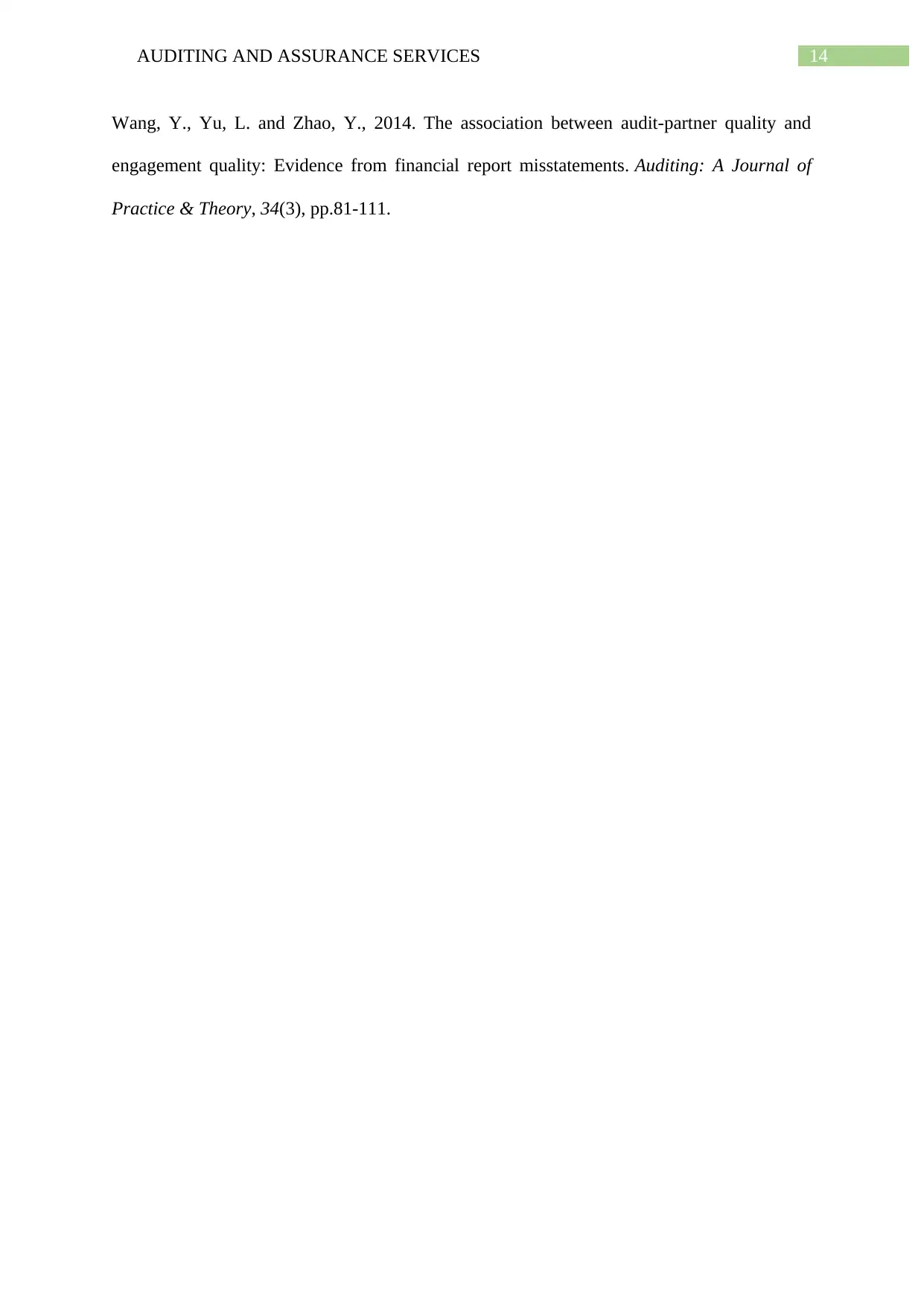
14AUDITING AND ASSURANCE SERVICES
Wang, Y., Yu, L. and Zhao, Y., 2014. The association between audit-partner quality and
engagement quality: Evidence from financial report misstatements. Auditing: A Journal of
Practice & Theory, 34(3), pp.81-111.
Wang, Y., Yu, L. and Zhao, Y., 2014. The association between audit-partner quality and
engagement quality: Evidence from financial report misstatements. Auditing: A Journal of
Practice & Theory, 34(3), pp.81-111.

15AUDITING AND ASSURANCE SERVICES
Appendices
1. Key Audit Matters in Inventory for Reliance Worldwide Corporations Limited
Appendices
1. Key Audit Matters in Inventory for Reliance Worldwide Corporations Limited
Secure Best Marks with AI Grader
Need help grading? Try our AI Grader for instant feedback on your assignments.
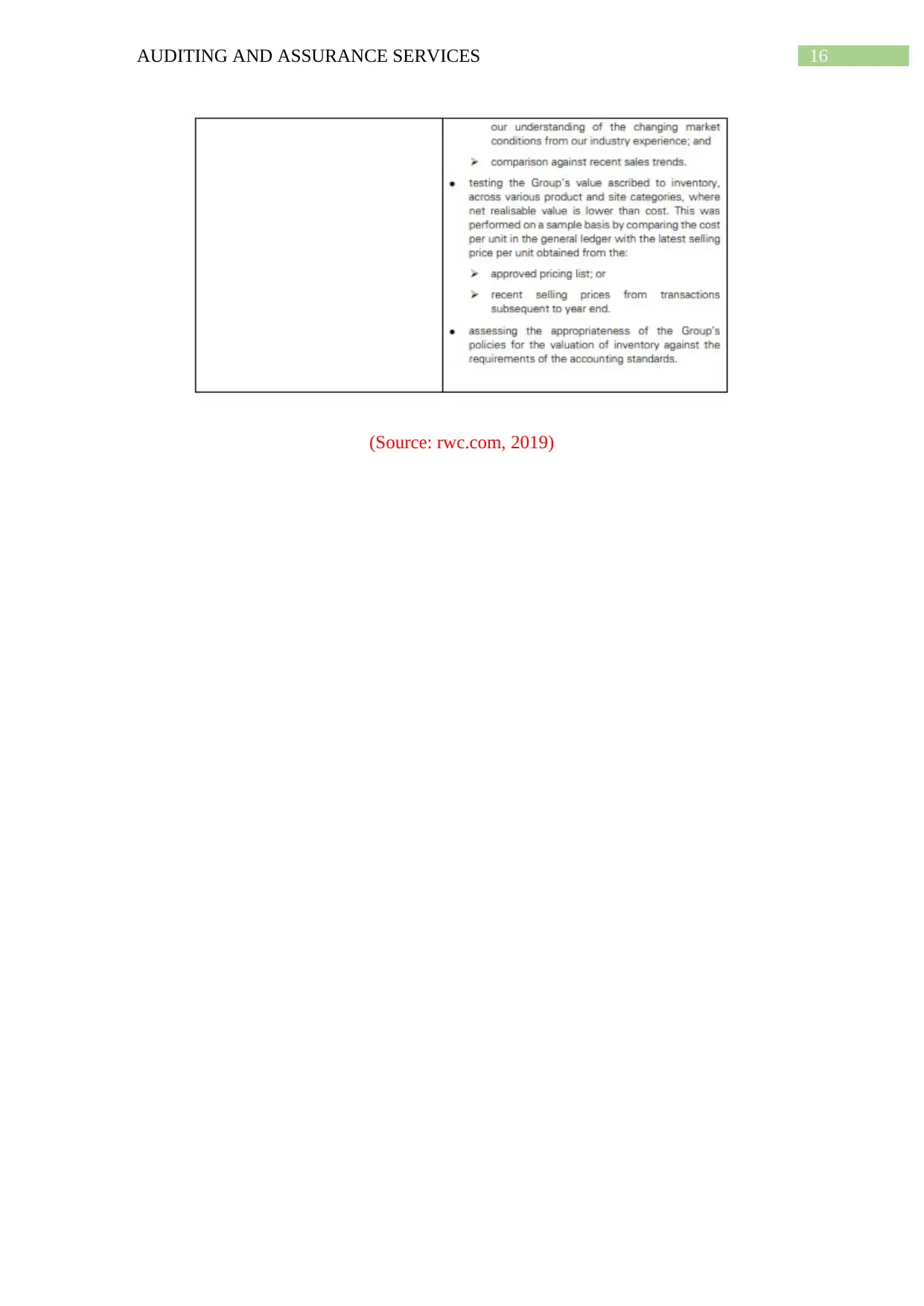
16AUDITING AND ASSURANCE SERVICES
(Source: rwc.com, 2019)
(Source: rwc.com, 2019)
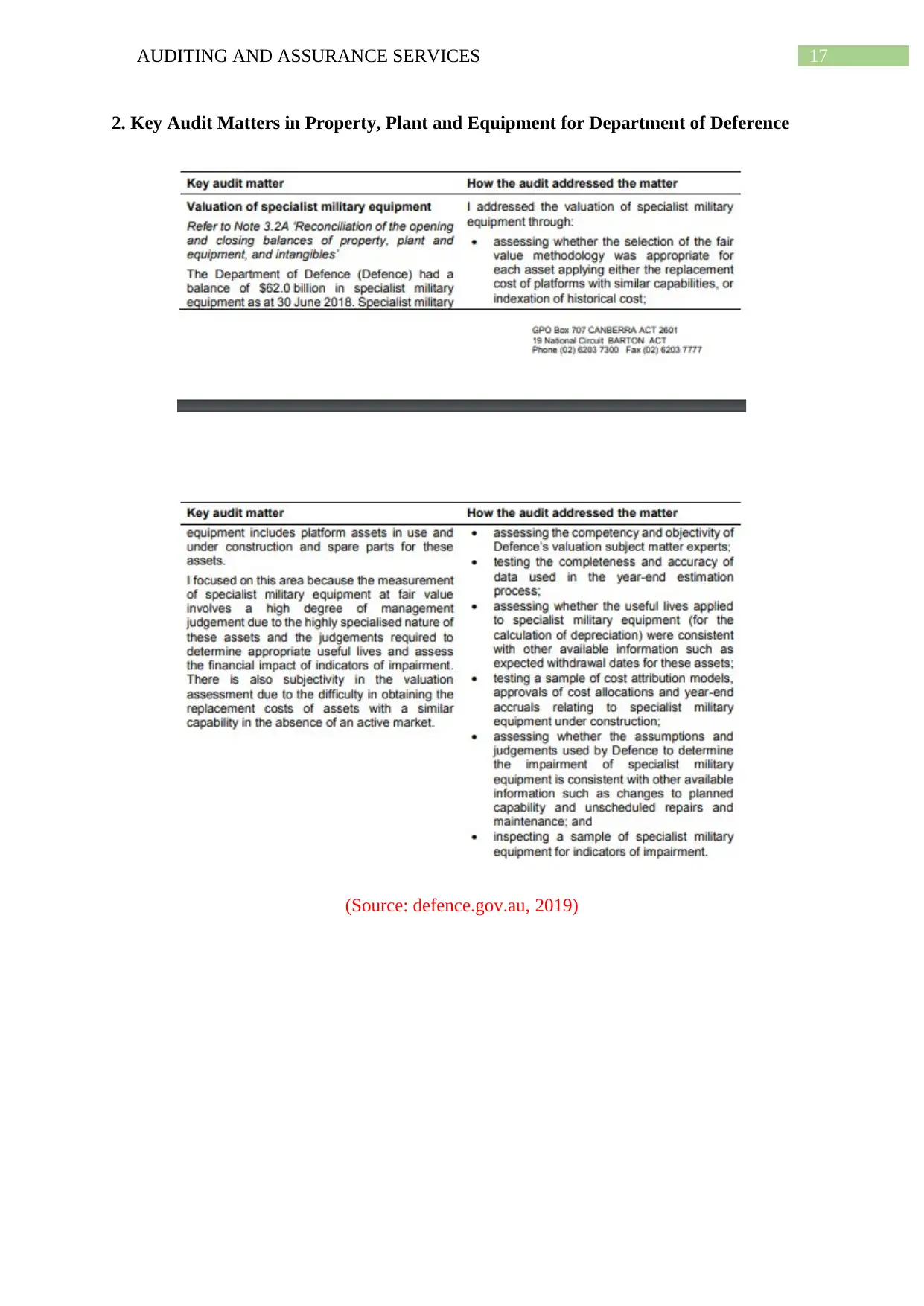
17AUDITING AND ASSURANCE SERVICES
2. Key Audit Matters in Property, Plant and Equipment for Department of Deference
(Source: defence.gov.au, 2019)
2. Key Audit Matters in Property, Plant and Equipment for Department of Deference
(Source: defence.gov.au, 2019)
1 out of 18
Related Documents
Your All-in-One AI-Powered Toolkit for Academic Success.
+13062052269
info@desklib.com
Available 24*7 on WhatsApp / Email
![[object Object]](/_next/static/media/star-bottom.7253800d.svg)
Unlock your academic potential
© 2024 | Zucol Services PVT LTD | All rights reserved.




